
Thursday September 30, 2021
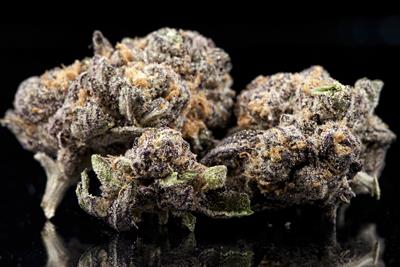 Growing
Growing
Few things in the world of weed have as large a mythic and iconic standing as purple bud. Despite its popularity, this seemingly simple topic can be a bit convoluted. What is purple weed? Why is it purple? How does it get that way? And ultimately, does weed color matter at all?
Join us as we take a look at the myths and facts about purple weed.
Table of Contents:
- Why Weed Turns Purple
- What Makes Cannabis Purple
- How Cannabis Changes Color
- Does How a Plant Is Grown Make It More Purple?
- Can You Stress a Marijuana Plant to Make it Turn Purple?
- Is Purple Marijuana Better?
- Why is Purple Weed Popular?
- Popular Purple Cannabis Strains
- Facts and Myths About Growing Purple Weed
- How to Grow Purple Marijuana
- Experimenting With Purpling Techniques
- Conclusion
Why Weed Turns Purple
Purple cannabis gets its hue from the presence of pigments called anthocyanins.
Anthocyanins are water-soluble pigments present in many plants. Purple cannabis has a naturally higher amount of anthocyanins, and weed turns from green to purple as these anthocyanins are expressed during the growing cycle.
Now that we know why weed turns purple, let’s take a look at how it happens.
What Makes Cannabis Purple
Despite the “cyan” in “Anthocyanins” referring to their blue tones, these molecules occur in a range of colors, and that range is determined by the acidity of the solution they are in. Anthocyanins will present in a range of pink to red at high acidity, a range of purples (even approaching black) from medium to neutral acidity, and finally a greenish-yellow to no color at all when alkaline. Thus, anthocyanins don’t just make weed purple, but a range of other colors as well.
Anthocyanins are also part of a larger class of molecules known as flavonoids, which aside from how the name sounds, have very little to do with flavor (and are actually astringent tasting, so not very appetizing). The “flav” in flavonoids comes from the Greek word for yellow, flavus.
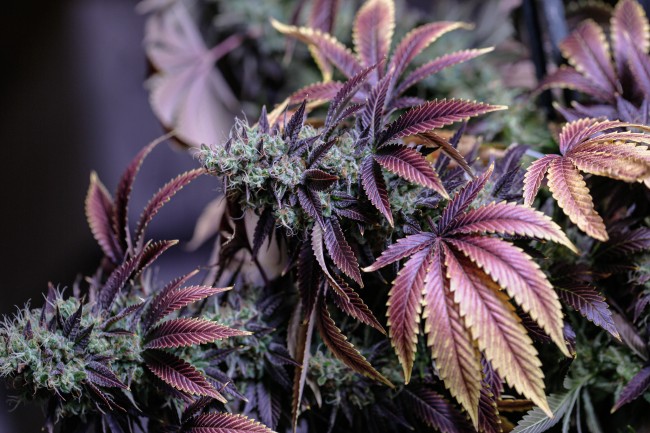
So what is happening here? Why is a blue-named class of molecules (that presents as red or purple) a subset of a class of yellow-named molecules. It begins to make sense when we consider that a complex interaction of anthocyanins and other flavonoids is what causes leaves to change color among such a brilliant spectrum in the fall.
When cannabis presents as purple, we are seeing a similar phenomenon as fall leaves, where the shift in conditions influences the pigment molecules to present different colors.
How Cannabis Changes Color
Like other plants, for cannabis, changes in coloration serve a purpose. Under natural conditions, cannabis sativa grows during the spring and summer, then flowers seasonally in the fall and winter months. It makes these changes based on a shift in photoperiod, the amount of time that plants are exposed to light per day.
During the early stages of the plant’s life (propagation and vegetation) the plant will devote energy to making food for itself to help it grow. It does this by producing chlorophyll, also known as the stuff that makes plants green. Chlorophyll is what helps plants convert light to energy, therefore, the more chlorophyll there is, the more energy the plant can draw from the sun to sustain itself.

When the growth stage is done, the plant then prepares to reproduce. It will begin to decrease the chlorophyll production needed to grow, and instead devote energy to flowering and seeding, in an effort to create the next generation of pot plants. The more flowers or seeds it can make, the better chances it has of genetic survival, so it will try and devote as much energy as possible to this stage.
As a result of chlorophyll production decreasing, the cells containing chlorophyll then begin to break down, revealing the anthocyanins present. If a cannabis plant has a high amount of purple anthocyanins, it can then appear to turn from green to purple at this stage.
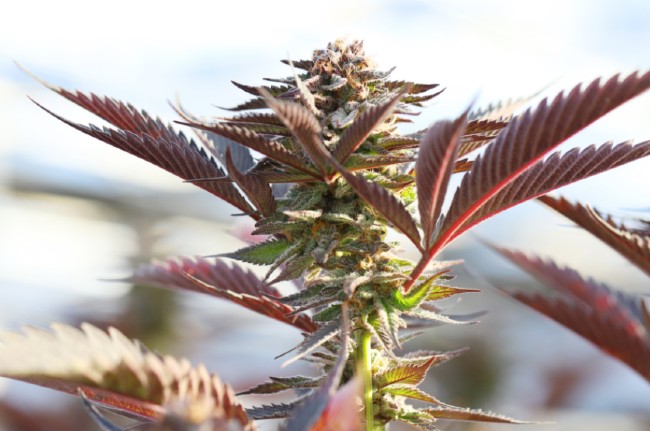
However, cannabis’ ability to present darker pigments, and to what degree, is wholly dependent on the plant’s genetics. The amount of anthocyanins a given plant produces “beneath” the green chlorophyll is determined by the plant’s genetic makeup.
Without a predisposition to purpling, a strain cannot be induced to turn purple. Certain strains will have more naturally occurring anthocyanins than others, and when switching to the “winter” cycle of flowering, will start to express those purple pigments according to their genetic predisposition interacting with the unique chemical and environmental factors in which the plant is grown.
Does How a Plant Is Grown Make It More Purple?
A plant that produces no purple anthocyanins cannot be made to turn purple. When a cannabis plant becomes purple, what we are seeing isn’t one color changing into another, but rather one color being removed to reveal another. Without that anthocyanin base for pigmentation, no change in appearance will take place. Furthermore, whatever color those pigments are without the green chlorophyll in the way is the color that the cannabis will turn to. This is why there is also pink and red cannabis as well.

While genetics will determine the amount of anthocyanins and their general color, the ranges that those colors present in will be impacted to some degree by the environment they are grown in.
We can understand this better by looking at the difference between phenotype and genotype. The genotype of a plant is based on its hard-coded genetics. Consider it the “ideal” form of the plant that emerges when grown under optimal conditions. If we think of a typical store-bought tomato, it would be bright red, with a generally round shape, and a bright green top.
However, if you grow two tomato seeds from the same plant under different conditions, the results may look different. One may not be as red as the other, or it may grow smaller or larger than expected. The extent to which its base genes are expressed is different, making the resulting plants have distinct characteristics. These different expressions of the same base genetics are known as phenotypes. The genotype may influence how phenotypes come about, but the results are unique to that plant. Furthermore, a plant can’t go beyond the possibilities of its genotype, it will have to work within the genetic framework it's given.
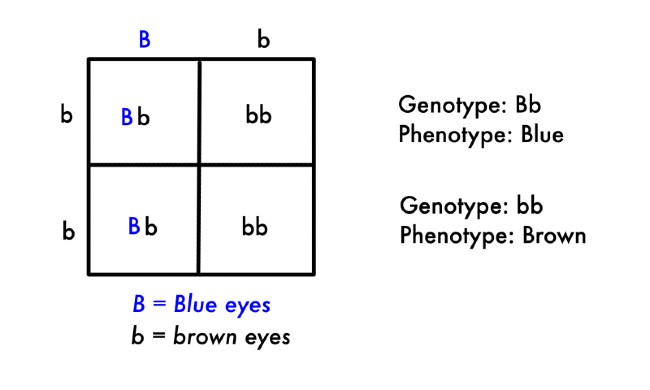
Thus, you can grow a tomato that is more or less red than others from the same plant, but without a genetic trait that allows it to do so, you couldn’t naturally grow a blue tomato.
Can You Stress a Marijuana Plant to Make it Turn Purple?
To better understand this connection, I spoke with veteran grower and concentrate connoisseur Matt Gosling about the popularity of purple cannabis. Matt has overseen numerous harvests over the span of Colorado’s legalization waves and has amassed a good amount of experience dealing with purple weed. While purple bud can be fantastic, he explained, it’s usually due to good breeding and genetics, and not much else.
“Purples are memorable. If you have a good high with purple bud, it’s going to stand out. Then, if you’re a grower and you have the ability to then reinforce those genetics, you’re going to, and it propagates itself from there.”
Can you grow a purple-leaning cannabis plant to be a bit more purple? Possibly, but you might not want to. Many growers believe that stressing a plant can induce it to produce deeper pigments, but it might do more harm than good.
Matt continued, “Any energy the plant spends pushing out that purple pigment is going to be drawn from somewhere else and is going to hurt overall. It’s just not worth risking the quality for a chance at a slightly better bag appeal.”
Is Purple Marijuana Better?
Visual appeal aside, is there reason to believe that these purple flowers are better than the green buds more common to the plant? The science leans towards no, at least for smoking it.
According to the European Food Safety Authority, there is no substantive evidence anthocyanins have any effect on human biology or diseases – though they contain a higher concentration of antioxidants, (which would theoretically only be beneficial if one were eating buds directly or juicing marijuana).
There is some minor proven correlation to anthocyanins as an anti-inflammatory, but again, would probably be more active if ingested. Seeking a strain with higher CBD content like AC/DC might be a better source for anti-inflammatory effects than looking for one with a purple hue.
There are also some anecdotal reports that purple bud has a tendency for lower THC content than its greener counterparts, and this mostly comes from growers. However, that’s not to say high-THC purple is not possible, but energy spent towards inducing pigmentation can mean less energy put towards THC production, possibly explaining the popularity of this claim. In general, bud coloration doesn’t seem to have much of a correlation with cannabinoid content. The plant’s genetics and how well it is grown will be the ultimate determining factor.
Why is Purple Weed Popular?
The popularity of purple cannabis is indisputable in the modern cannabis market. Anyone who has worked as a budtender (myself included) will tell you, it’s an incredibly common request at dispensaries. Why do people love purple weed?
As Gosling infers above, the primary reason is likely the simplest: because it’s memorable. The majority of weed is some shade of green, and purple stands out. Humans are highly visual creatures, and if we can identify something by sight alone, we’re more likely to return to it later.
If you smoke a purple strain once and enjoy it, by having the visual marker, when others lack such distinct characteristics, any good memory is more likely to be imprinted.
Beyond visuals, the prevalence of purple cannabis in modern culture is heavily perpetuated in music. Jimi Hendrix’s “Purple Haze,” is continually brought up when purple cannabis is discussed. Many a stoner will tell you all about how the lyrics are coded references to cannabis or psychedelics.

However, contrary to popular belief, the writing of “Purple Haze” has nothing to do with the strain of the same name, or drugs of any sort. Hendrix himself spoke of the song in context of a dream-like science-fiction ballad. He later noted his frustration at not being able to more fully develop the themes in the final work. It turns out that “Purple Haze” isn’t about getting so high that it feels like an alien mist has taken over your mind. Instead, it’s about what it would feel like for an actual alien mist to take over your mind.
However, in the current cultural understanding of cannabis, the original intention is irrelevant. The connection is too ingrained. Purple weed is that popular.
Fast forward to modern music and you have an almost endless list of hip-hop and rap songs praising the purple. Take your pick among “Purple Swag,” by A$AP Rocky, Juicy J’s “Purple Kush,” “Blueberry Yum Yum” by Ludacris, or “Purple” by Mac Miller. And those are just songs with purple references in the title, countless lyrics have been penned in a similar vein.
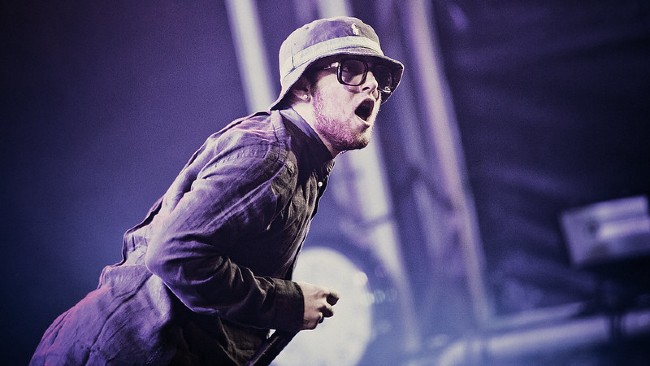
The notoriously purple strain Purple Urkle is so famous that it has looped back around on itself in popular culture. Actor Jaleel White, who played the character Steve Urkel on the sitcom Family Matters (and is the inspiration for the strain Purple Urkle) is now launching a cannabis brand titled, ItsPurpl, which will put out cultivars crossed with the famous strain. White said he started the brand specifically to cater to the popularity of purple cannabis. He told Forbes:
“The thing that always stood out to me was there was no clear brand leader for fire purple weed. It made no sense to me, that no company of significance had claimed this lane, so why not me?”
Family Matters ended its final season in 1997. Soon, there’s likely going to be an entire generation of cannabis consumers who don’t know Jaleel White as Steve Urkel, instead he’ll be “the guy that owns ItsPurpl.”
Finally, purple weed is popular because some of it is very good! None of this would matter if there weren’t some excellent purple strains available for people to have positive associations with. Because it is so easily recognizable, if all purple cannabis was terrible, or even markedly worse than other colors, consumers would remember that just as intensely as their positive memories with purple strains. While purple weed is not necessarily better or worse than any other colored cannabis, that doesn’t keep some purple strains from being amazing.
Popular Purple Cannabis Strains
If you’re looking for some reliably purple buds, these strains are known to genetically produce high amounts of anthocyanins to give you those purple tones:
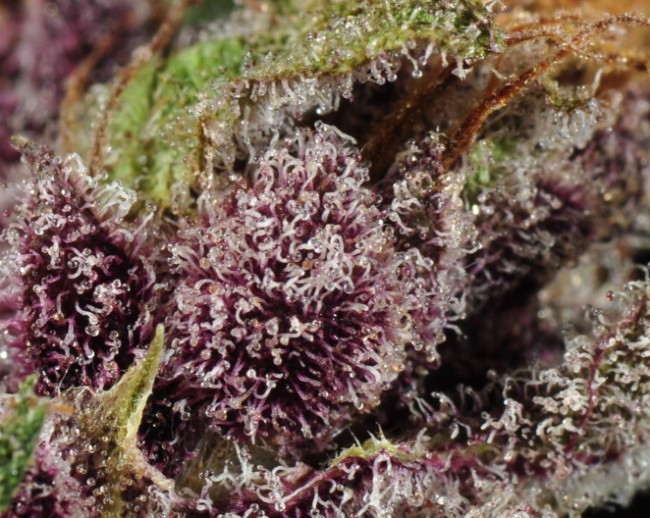
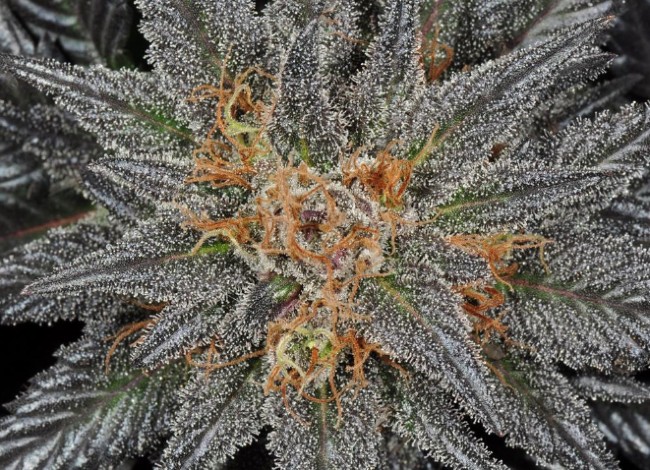



Facts and Myths About Growing Purple Weed
Some people believe that there are countless growers out there who bring out purple hues by manipulating the plant, however, the prevalence of such practices seems to range from an uncommon rarity or a myth or rare in pr. I rattled off a list of alleged techniques for inducing purple bud to Matt, such as affecting nutrient levels or flash freezing, and he quickly declared them bunk. He kept returning to the same truth: healthy happy plants make better weed than stressed plants.
That’s not to say attempts at purpling don’t occur at all, “I’ve seen some people use ice water to do their flush,” he told me, “some other tweaking with light timing, but I don’t recommend any of it.”
How to Grow Purple Marijuana
The best way to grow purple weed is to cultivate plants with genetics that turn purple naturally. We went over some of the other more prevalent methods in more detail to separate myth from fact.
Freezing Cannabis Plants to Make Them Purple
While details differ slightly among growers, a commonly referenced technique to turn a cannabis plant purple is to shock it with cold. The idea is to signal the plant that it is entering an intense winter period, meaning light will soon be scarce, and it should stop attempting to collect light with chlorophyll.
A lighter variation of shocking the plant with cold is to simply drop temperatures late in the growing cycle to signal the same response. Mild temperature manipulation may actually induce some purpling as it can accelerate the breakdown of chlorophyll.
Temperature manipulation can be done with refrigeration, air conditioning, or plain ice. These measures are usually done during the growing stage, especially as the switch to flowering approaches, though sifting through growers’ forums will result in people advising any timeline you can imagine. The success of such methods seems varyl, and the basic rule remains: purple genetics are still the best way to make purple cannabis.
As Matt mentioned, he has seen people try ice-water flushes, but is skeptical about the impact of doing so. A flush is performed in the last days of a plant’s life cycle before it is harvested, a point at which anthocyanin production should be complete, and chlorophyll degradation is already in motion. If there is any change from icing the plant’s, it would likely be minimal. Still, some growers will swear by it.
Nutrient Manipulation to Induce Purpling
Another urban legend in the realm of purple cannabis is that there is some special blend of nutrients that will result in purple flowers. This idea appears to be a bit more scientific on the surface. As we have seen, changes in acidity will affect the coloration of anthocyanins, but the theory falls apart a bit in practice.
Affecting pH levels in the soil will certainly have effects on a cannabis plant. All plants have an ideal acidity level that they grow at, and cannabis is no different. While cannabis has a range of effective pH to play with, going outside of that range may hurt the plant.
Anthocyanins are more purple the closer to neutral acidity (7), and cannabis plants thrive in slightly acidic soil 5.8-7pH. Lowering that acidity in the hopes of gaining more purple may come at a direct cost of growing better cannabis.
A study performed with Hydrangeas appears to indicate that soil acidity does not directly impact anthocyanin levels, but it can affect coloration. However, the study notes:
“Anthocyanins are unstable molecules and very easily degraded. The stability of anthocyanins are influenced by pH, temperature, light, oxygen, the structure and concentration of anthocyanins, as well as the presence of other components such as flavonoids, protein, and minerals.”
Whatever tweaking that was done for one plant to turn purple might do nothing for another plant, or actively hurt it. Either way, we’re back to the same issue, if doing these things may result in slightly darker buds, those buds are likely to be of lower quality than if the grower had been focused on growing the plant as best as possible.
Purple Dyes or Sprays
If you talk about purple weed for long enough, someone will inevitably bring up a friend of a friend of a cousin that once saw someone artificially color cannabis flowers to appear purple. Though it is possible to dye weed, this practice is uncommon, and let us also state the obvious and say that if you do encounter artificially colored cannabis, don’t consume it.
The majority of information regarding how dying cannabis affects the final buds and quality of smoke has been anecdotal, but so far on of the most detailed first-hand accounts appears to be from a post by user fdd2blk on the rollitup.org forums titled, “The color of my dreams” (sic).

Fdd2blk was able to get a cutting from one of their plants to turn blue after soaking it in food coloring. They reported that the dye even made it into the trichomes. Impressed with their work, fdd2blk went on to try and smoke the flower after it had cured to disastrous results. In a follow up report, they wrote:
“i smoked it. DO NOT DYE YOUR WEED!!!!!!!!!!!!!!!!!! IT TASTE LIKE POO POO!!!!!!!!!!!!!!!!!!!!”
We left their response as-is to illustrate just how strong the impression was. Fdd2blk reported they didn’t make it past 3 hits, and concluded, “blue weed is for smurfs.”
If flower is purchased from a licensed cannabis business in a legalized state, that cannabis will have to undergo rigorous chemical testing for contaminants, dyes and other foreign substances. Bud that did contain these would not pass inspection, and thus not make it to the shelves to be consumed.
But what about black market bud? The majority of postings on cannabis forums asking about dying weed do seem to have the overt goal of improving bag appeal (as Matt guessed at above) to be able to sell it for a higher price. While the practice may be very uncommon (especially when the outcome is unsmokable weed), it does appear that some folks are trying to attempt it.
Finally, spraying some sort of coloring onto the plant or buds after harvesting, the way that some landscapers paint patches of dead grass green is even less likely to be encountered, as it would also make the bud unsmokable. This would almost certainly never happen in bud from a regulated dispensary, and if you encounter it anywhere else, steer clear.
Experimenting With Purpling Techniques
We’ve discussed at length how the best way to get purple cannabis is to grow plants with a strong genetic predisposition to purpling. Any additional efforts to force a color change can ultimately result in lower quality weed.
However, if you’re looking to experiment and have some resources to spare, trying out some of the safer methods to induce purpling can be a good educational experience to see how soil acidity or temperature manipulation can affect bud color and growth. Cannabis growing knowledge is always advancing. If you do discover some good methods for consistent results, share your findings with other growers!
Conclusion
In the end, it would seem that in order to make high-potency well purpled flower, the only thing you can do is find a strain with purple-leaning genetics and grow it as ideally as possible to express those traits. When plants are stressed into becoming purple, what you’re really seeing is a rapid degradation of chlorophyll in an already purple-tinged plant.
In speaking with growers, budtenders, and other cannabis journalists, the consensus among the industry is to treat each harvest as unique–smoke what appeals to you. If the effects of purple strain are appealing, go for it. However, aiming to make weed purple by any method involving stressing the plant may work to some degree in that it can remove more chlorophyll, but is more likely to harm the plant and final product.
Furthermore, no one is wrong to feel that the visual appeal of a flower can enhance the smoking experience. Purple bud can be fun, and an appreciation of it doesn't need to be any deeper than that. Ultimately, the mere presence of the pigment is unrelated to the resulting effects. If the flower is good, by all means smoke it, in any spectrum of the rainbow.
What are your thoughts on purple weed? Do you find it to be better than green buds?







